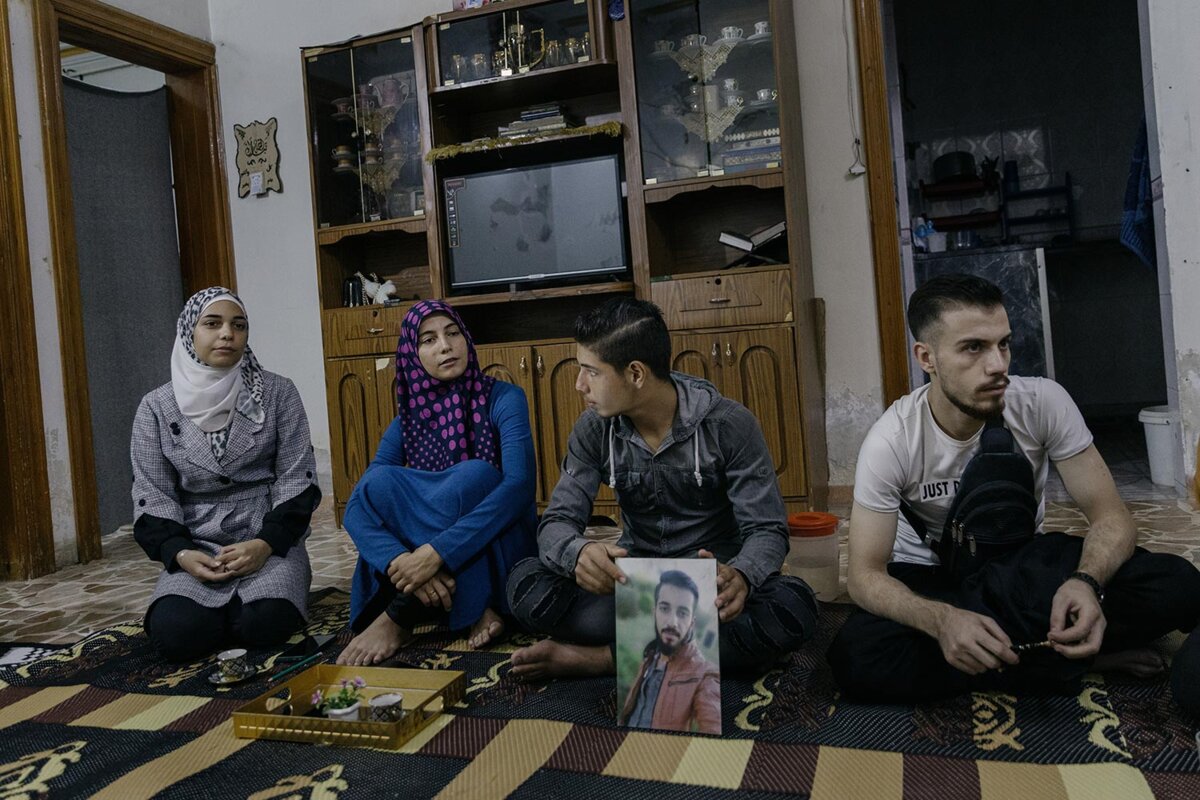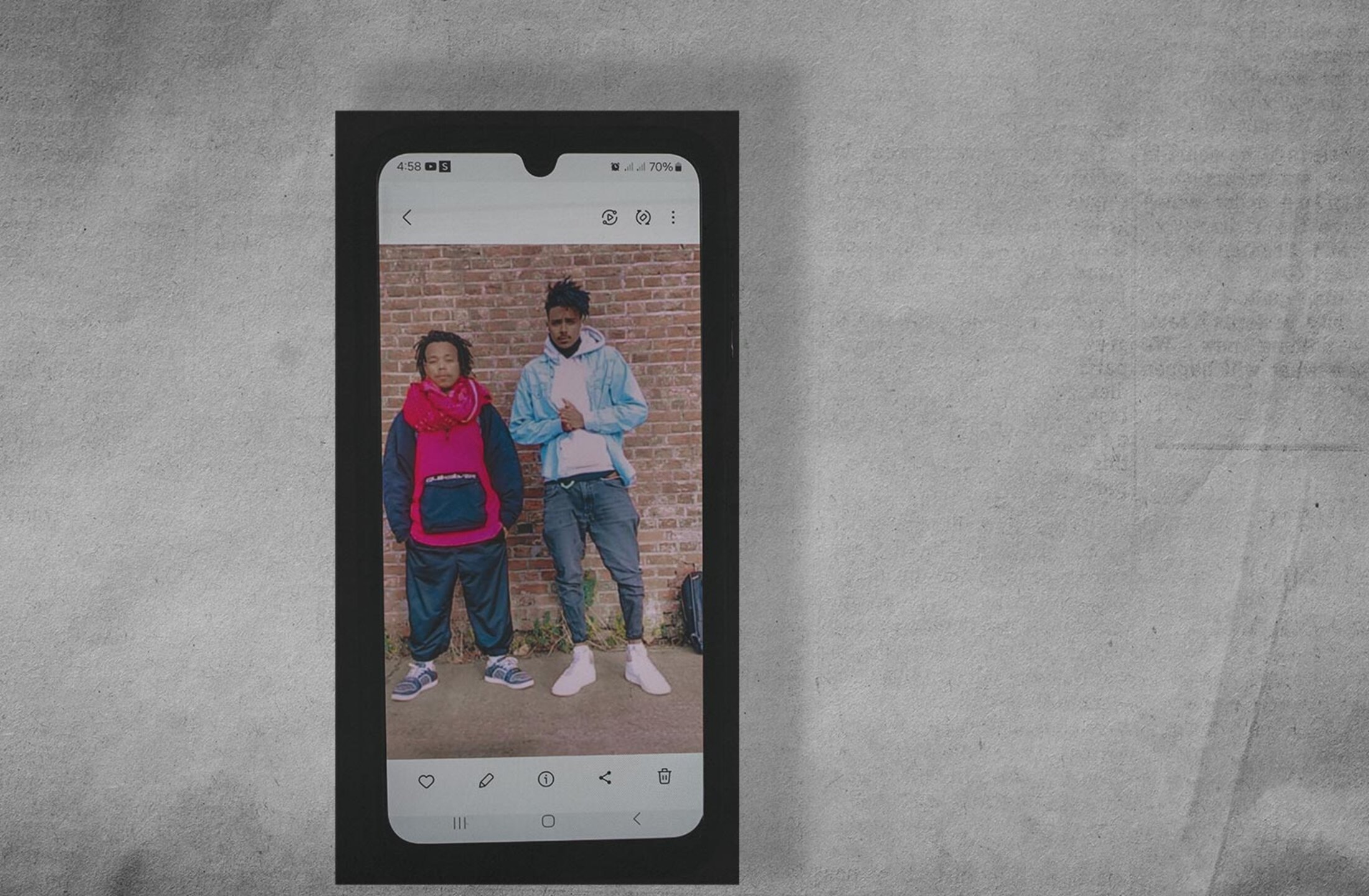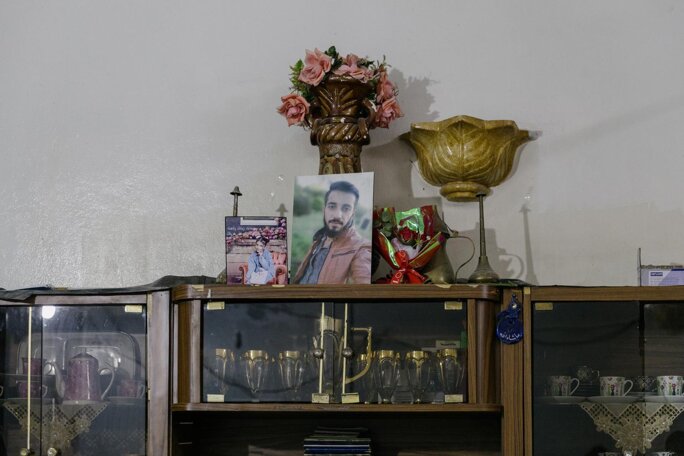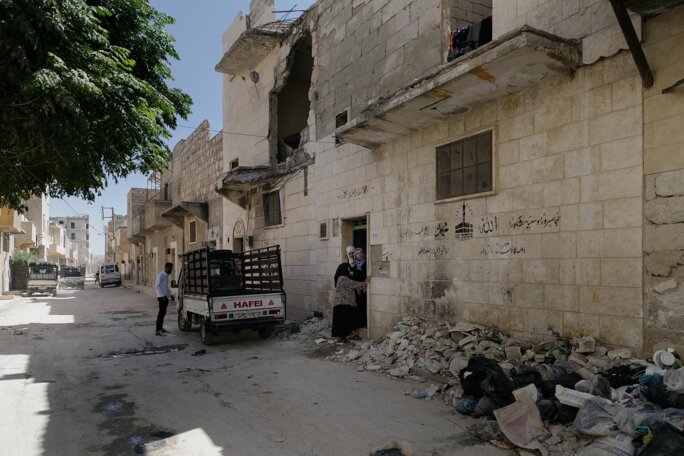In the modest home of the Bakro family, in the Masaken Hanano district of the town of Aleppo, in north-west Syria, 21-year-old Lamees, showed Mediapart a video, barely a minute long, which she has kept preciously on her smartphone since October last year.
The images showed her brother Mustafa, aged 27, and two of his friends joking as they anchored a Quechua pop-up tent in a makeshift camp in the centre of the north-east French port of Calais, close to the town hall with its 72-metre-tall clocktower and belfry. In the short recording, a train passes by, heading for the port’s freight zone.
While Lamees was showing the video, around a dozen of Mustafa’s family and friends sat with her, some on mattresses, others on a patterned carpet. They had come along to talk about him, the eldest of the Bakro family’s children, who had left his hometown for Europe, fleeing the dreadful conditions in Masaken Hanano, which for 14 years was on the frontline of Syria’s civil war, as testified by the façade of the family’s house, partly blown open from shelling. The video was the last contact that Lamees and her family received from Mustafa.

Enlargement : Illustration 1

It was on October 23rd 2024, just a few days after the video was recorded, when Mustapha joined dozens of other migrants aboard an inflatable dinghy, leaving the French coast close to Calais in the early morning on a clandestine journey to England, around 35 kilometres away. But shortly after it left, the boat began taking on water and sank rapidly off the town of Sangatte, close to Calais. That was when Mustapha disappeared.
The French maritime rescue services saved 48 people from the dinghy, while the official toll of the incident was first reported as three dead and one injured. Some survivors from the boat estimated it was carrying between 60 and 70 people, and Mediapart would soon reveal that in fact at least 13 people on board the boat were missing, bringing the possible total of dead to 16.
Questioned by Mediapart this month as to whether the official toll of the sinking had evolved over the past year, France’s maritime prefecture in charge of policing French waters in the Channel and the North Sea offered no response.
“In the days that followed the sinking, we contacted the Red Cross, the Red Crescent, the police and also human rights organisations in France,” said Lamees*, who is studying communications at Aleppo university. “The last time we had been in touch with the Red Cross, they replied that they were going to get back to us when they would have some news. That was four months ago, nothing has happened since.”
Now, one year after the events, the family feel a mixture of sadness and anger. “We don’t understand what could have happened, the zone where it sank is close to the shore,” said Mustapha’s brother Ahmed*. “Normally, the French authorities should have been able to save Mustapha and all the other shipwrecked, or at worst found the bodies."
Over the two months following October 23rd last year, the date of the sinking, a total of 13 bodies were recovered in France from the Channel, either floating in the water or found washed up on beaches. These included several bodies found within a fortnight of the sinking of the dinghy on which Mustapha was travelling. One corpse was discovered on the beach at Sangatte on November 2nd, and two more corpses were found three days later in the sea off Calais. The following day, a body was found on a beach at Calais, while two others were retrieved from the sea close to the port.
Mediapart understands that until now, just four of the 13 corpses have been identified, and all of them were people declared by their relatives to be missing following the October 23rd 2024 sinking. The bodies have been returned to their families. However, the friends or families, from Syria, Eritrea and Ethiopia, of nine others declared missing after the sinking are still waiting for news of their fate.
At the end of January this year, the gendarmerie (one of France’s two police forces, along with the Police Nationale) created a special unit, called the NODENS, dedicated to the identification of bodies found on the north-east Channel coast. It is made up of five investigators, assigned to cases opened by the public prosecution services. The investigators are also tasked with identifying the bodies found following the October 23rd 2024 sinking.
But along the stretch of coastline of the Côte d'Opale, which includes Calais, Sangatte and Dunkerque, the authorities have ploughed nearly all their means into a strategy of repression. Around 1,200 police and gendarmerie officers have been mobilised to prevent the clandestine crossings of the Channel and to demolish the makeshift campsites set up by migrants. For that purpose, Britain has allocated 600 million pounds sterling (close to 680 million euros) in funding, to cover the period between 2023 and 2026, to equip the French policing authorities with drones and other surveillance tools.
In a report on the subject of the “Phenomenon of migrants going missing or subjected to enforced disappearance”, published in July this year, the United Nations’ Special Rapporteur on the human rights of migrants, Gehad Madi, observed: “The militarization, externalization, securitization and criminalization of migration prevents migrants from reaching their countries of destination in a safe, regular and legal manner, rendering asylum applications and further human rights protections out of reach.”
Slow and disjointed investigations
The report also highlighted numerous shortcomings in investigations into the disappearances of migrants. These include slow processes of identifying individuals, poor coordination with the authorities in the countries from where migrants in question originate, and a lack of proper contact and follow-up with the families of the disappeared, all of which is further aggravated by language barriers.
On November 14th 2024, a man walking along the beach at Calais discovered a corpse lying a few hundred metres from the entry to the port. The report by gendarmerie officers described the body as that of “a man, an adolescent or young adult, measuring 1.79 metres, [weighing] 65 kilos, of African type”. On the third finger of his left hand was a ring.
Two weeks later a man walked into the offices of the Red Cross in the city of Lille, 100 kilometres south-east of Calais, to record a missing persons statement. He told staff that since October 22nd he had lost trace of a member of his family, a man named Bokhit Haroun, who was from Chad and aged 27. He had last been seen at the railway station in Calais, the day before the sinking of the dinghy in which Mustafa Bakro disappeared. The man gave the Red Cross physical details of the missing family member, which included his size, which he said was about 1.75 metres, a silver ring on his third finger, and a scar on his nose.
Three days later the Red Cross notified the NODENS about the missing persons statement, and transmitted to the gendarmerie investigators the physical description given of Bokhit Haroun, underlining the strong similarities to the description of the body found on November 14th. However, over the following six months nothing appears to have been done on the case. It was only on May 2nd this year that NODENS reported the possibility of a link between Bokhit Haroun and the corpse found on the Calais beach.
Then, in August, Haroun’s relative, the man who launched the case with his statement to the Red Cross, was sent photos by the gendarmerie of the personal items found on the body of the man discovered nine months earlier on the beach in Calais. The relative recognised the objects, and notably the silver ring that Haroun used to wear. But despite that, and a DNA sample sent to France from one of Bokhit Haroun’s uncles in August this year, the family of the young man have been given no indication by the French authorities of his fate.

Enlargement : Illustration 2

The slow progress of the identification process is above all due to both the absence of direct contact with the families of the missing, and the lack of an efficient and cost-free method for the use of the DNA test kits. The father of Amanuel Berhe, another young man who disappeared after the sinking of the dinghy on October 23rd 2024, and whose case was previously detailed by Mediapart, is still waiting for a DNA test kit that was supposed to be sent to him last December.
In late November last year, the Red Cross gave NODENS the contact details for Amanuel Berhe’s father and friends. By the middle of December the gendarmerie investigators obtained a postal address via which they could reach the father. The magistrate heading the investigations into the unidentified corpses gave the green light for sending a DNA test kit to the address through the post.
One and a half months later NODENS discovered it could not send the kit via Chronopost, the French Post Office’s parcel and documents delivery service, because the return of the kit (with a DNA sample) would have to be paid for by Berhe’s father. While the gendarmerie investigator in charge of the case explained then that she was looking for an alternative solution, the father is still waiting to receive the equipment.

Enlargement : Illustration 3

Mustafa Bakro’s sister Lamees is one of the rare relatives of those who disappeared on October 23rd last year to have had direct contact with the gendarmes at NODENS, but she too has come up against the same problem with receiving a DNA test kit. In the middle of January, she was sent an email by a gendarme in which it was explained to her that she would be sent a DNA test kit and that to send it back would likely cost “around 60 euros” (while the DNA profile would subsequently be developed in France at the state’s expense).
In her reply Lamees asked whether an association might be able to help with the cost to her family, because “we do not even have 60 euros, I am really sorry”, adding that it was because of the situation in Syria. The gendarme initially advised her to make contact with the Red Crescent, but unable to give her direct contact details for the organisation he then suggested that she approach the Red Cross in France. Ten months on, no progress has been made.
Against this lack of coordination between the different players, several associations helping with the identification process were informed by NODENS that it was working with the French Post Office to allow the families of the disappeared to send back the DNA test kits free of charge. Contacted by Mediapart, neither NODENS, nor the public prosecution services, nor the Red Cross responded to questions submitted to them about whether that was now in place, or what progress overall has been made in the investigations post-October 23rd 2024.
A sentiment of abandonment
In face of the obstacles, the justice authorities have agreed to occasionally bypass the requirement for DNA confirmation of a dead person’s identity. In the case of Amanuel Berhe, the magistrate in charge of that investigation accepted that his corpse be identified through visual recognition. Thus, on August 18th, the NODENS gendarme involved on the case questioned a person with knowledge of Behre (and who volunteered to be quizzed) about his size, personal items and notably a tattoo, for comparison with the discovered corpses. But again, neither the young man’s father or friends were contacted, despite their details being known to the gendarme since last November.

Enlargement : Illustration 4

Osama Ahmed is a 21-year-old Syrian who survived the October 23rd 2024 sinking, but in which his father, Ahmed Ahmed, was lost without trace. Osama was active in alerting the media to the numbers of disappeared in the days following the disaster. This month, while still without any information about what became of his father, he hired French lawyer Emmanuel Daoud to help with his case.
“Osama has had the impression that he was abandoned, that the investigation into the disappearance of his father was not followed up, and that there were insufficient means put into the process of identification of the bodies that were found,” said Daoud.
For now, the lawyer hopes to speed up the identification procedure. “The sinking happened on October 23rd 2024. Bodies were found between between November and December 2024. It’s now one year on and there are still corpses that haven’t been identified,” he added. “There are definite inadequacies, the procedural handling of this investigation is too slow. The question that is asked, and to which I don’t have an answer, is: would the situation be the same if it concerned French [people who had] disappeared?”
-------------------------
* The quotes marked with an asterisk are, exceptionally, taken from French translations of Arabic.
- The original French version of this report can be found here.
English version by Graham Tearse


